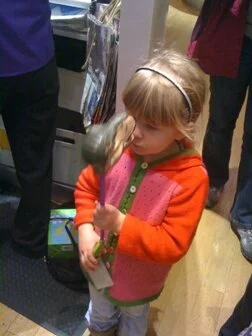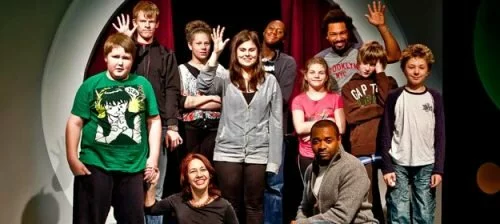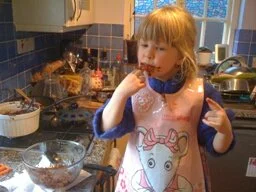Sorry it’s been six months since I updated this diary. Immediately post-diagnosis there seemed so much to assimilate and explain, and, although a lot’s happened in the intervening period, I’ve been tackling it on a day-to-day basis that hasn’t left me a lot of time for major reflection. I wanted this diary to have a fairly rigorous level of analysis, self-awareness, and self-criticism, but I’m beginning to think that’s unrealistic. Time is just moving too fast.
I can’t believe it’s been a year since my wife & I held each other in Hillingdon Hospital car park while the traffic guys sheepishly unclamped our Golf. Eva’s approaching the end of her reception class in mainstream school and her ‘disability’, to us, feels relatively invisible. It’s just who she is. Only when we look at the level of help she gets (15 hours one-to-one a week) and the brilliant effort the school are making (adapting her visual timetable, circle times, and assemblies to accommodate her reduced attention span; establishing fun traffic ‘stop’ signs to set her physical boundaries; working with the ASD specialists to educate Eva in social games and her classmates in why she’s ‘different’; using timers to define the lengths of tasks and rewarding her with a favourite activity when she completes one – rewards that her peers never get) only when we see all this do we realise how truly impaired our daughter is.
 Her reading is brilliant – equivalent to a seven year old - and her writing can be up to scratch when she can be bothered. Unfortunately her ASD means she’s too easily distracted and finds it hard to focus, which is where the one-to-one supervision really helps. Without it she wouldn’t complete the vast majority of tasks, and that’s why we’re currently filling in yards of forms to secure Eva a ’statement’ from the local Council.
Her reading is brilliant – equivalent to a seven year old - and her writing can be up to scratch when she can be bothered. Unfortunately her ASD means she’s too easily distracted and finds it hard to focus, which is where the one-to-one supervision really helps. Without it she wouldn’t complete the vast majority of tasks, and that’s why we’re currently filling in yards of forms to secure Eva a ’statement’ from the local Council.
This ‘Statement of Special Needs’ will be the Council’s confirmation that Eva needs extra help with her education. It will allow the school to tap the Council for more funding to increase her one-to-one hours so that her entire school day can be under adult supervision. Right now, Eva just takes up too much of her teacher’s time, and that isn’t fair on the rest of her class. Just as it isn’t fair that she bites and hits them when her frustration with interaction becomes too great to contain. Physical manifestations of internal conflicts are common enough for everyone, but they’re often Eva’s primary form of communication and unravelling the real meaning behind her behaviour can be challenging (see here for my description of the basic ‘Iceberg’ technique of behavioural analysis.)
 She hasn’t really made any friends at school as yet. She has girls who are protective toward her, but she’s more likely to play alone at an imaginary game of her own divising than tolerate the games of others. There are too many rules – written & unwritten – that she can’t understand, and so she chooses to go solo with her imaginary family. She has a sister (Abby) an older brother (Edward) and a naughty baby brother (Spencer) to take the blame when it all goes pear-shaped. They all have “black faces.”
She hasn’t really made any friends at school as yet. She has girls who are protective toward her, but she’s more likely to play alone at an imaginary game of her own divising than tolerate the games of others. There are too many rules – written & unwritten – that she can’t understand, and so she chooses to go solo with her imaginary family. She has a sister (Abby) an older brother (Edward) and a naughty baby brother (Spencer) to take the blame when it all goes pear-shaped. They all have “black faces.”
Eva is creating her own world on her own terms, which is a brilliant indication of her imagination, but unfortunately an all too easy sanctuary when the real world gets too much. Only yesterday she bit a boy quite badly on the arm as delayed retaliation for him having pushed her to the ground at playtime (a fact I only managed to get out of her after drawing through the events in a social story back home.) Eva was sent to the Headmistress, who demanded she apologise. Typically, though, Eva was ”having none of it” (in the words of her form teacher) claiming Spencer had made her do it, backed up by Abby, and it was their fault not hers. As a punishment I refused to let her scoot back to the car, and, although she wept bitter tears and tried to hit me several times, at least I didn’t have to drag her. She walked back all the way, calmly holding the buggy. She understood what she’d done wrong, and why her punishment was necessary, which is a start.
Meanwhile, television has been offering us a glimpse into a possible future. C4 has just finished screening ‘Young, Autistic and Stagestruck’, which followed several autistic kids on various points of the spectrum trying to put on a play at the Lyric, Hammersmith.
 Some of these kids could barely speak while others were very engaging. All had problems with concentration and memory, and almost all had never had any friends. I wept along with their parents as we watched them form proper lasting friendships for the very first time. ’Normality’, for these families, is something they try to forget but so desperately crave, because the alternative is isolation, loneliness, and depression; to the point - often with Autistic teenagers in particular – of attempted suicide.
Some of these kids could barely speak while others were very engaging. All had problems with concentration and memory, and almost all had never had any friends. I wept along with their parents as we watched them form proper lasting friendships for the very first time. ’Normality’, for these families, is something they try to forget but so desperately crave, because the alternative is isolation, loneliness, and depression; to the point - often with Autistic teenagers in particular – of attempted suicide.
Even the leading boy – in every scene and comparatively ‘normal’ – had a complete breakdown on the eve of the performance. We watched him be restrained by his parents, dragged into a room and pinned to the floor till he was calm. There was no anger, no frustration, just an abysmal sadness. ”This is why we don’t go out,” said his Mother, near tears, as she held him down, ”this is why we lock ourselves away.” One girl, Mollie (fifth from right in the pink T-Shirt) was so unco-operative the Director threatened to exclude her. With Herculean self-restraint her mother’s response was blunt: “She has been excluded from everything all her life, she will not be excluded from this.”
 And that’s my fear. Unable to connect with the social world in any meaningful way, I fear Eva will withdraw. I know she’s only four, but I see how lonely she is now, how much she wants a friend, and it breaks my heart to watch her face blank out when she’s not invited to houses, or when schoolmates just walk away in the playground. She doesn’t know what face to make, she doesn’t know how to react or reach out, and so she comes home and flies off on one because that’s her release valve; that’s her way to get the negative out.
And that’s my fear. Unable to connect with the social world in any meaningful way, I fear Eva will withdraw. I know she’s only four, but I see how lonely she is now, how much she wants a friend, and it breaks my heart to watch her face blank out when she’s not invited to houses, or when schoolmates just walk away in the playground. She doesn’t know what face to make, she doesn’t know how to react or reach out, and so she comes home and flies off on one because that’s her release valve; that’s her way to get the negative out.
Still, the amount of aid she’s getting is astounding, and, if we work together, I hope we can teach Eva that there is another way; that she doesn’t have to try to be ‘normal’ all the time; that she can be herself, and learn to accept that some of her ‘social circuits’ just aren’t wired up enough to make the same relationships we made. My template for this belief is – obviously, to anyone with an Autistic kid – Dr Temple Grandin:
She considers Autism to be a gift and totally accepts who she is, although even she’s on anti-depressants to stabilise her moods. Here’s Dr. Grandin being interviewed by Carrie Gracie on Radio 4 last month:
Eva, too, has a flair for visual design. She can draw, cut out, and assemble her own range of clothing – sticking them, piece by piece, to her own models. Her approach is spectacularly methodical and shows a fine grasp of colour co-ordination and pattern matching. I hope this is an indication of where her talents lie so we can follow Dr Grandin’s advice and give Eva the early focal point she’ll need to make it through mainstream education. I hope for so much, but know at least that Eva is a unique gift. She is our love, and I hope we’ll all have enough to help her be happy.
found it on google. nice. ill come back to visit.